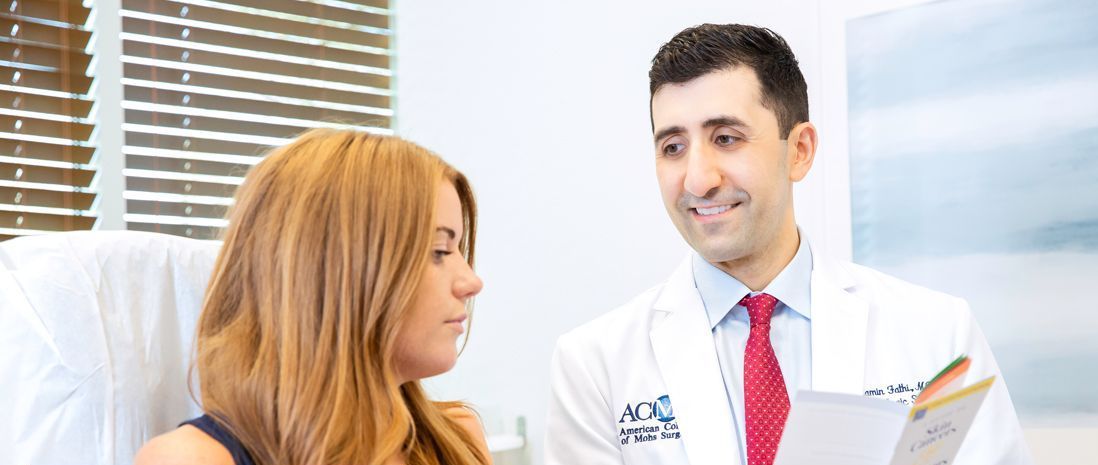Care for Cysts in Phoenix, AZ
Expert diagnosis and removal of epidermal cysts.
Epidermal Inclusion Cysts: Causes, Symptoms & Removal Options
Epidermal Inclusion Cysts (EICs) are the most common type of skin cyst and frequently occur in otherwise healthy individuals. Although often mistakenly referred to as sebaceous cysts, EICs do not originate from sebaceous glands, but rather from the outermost layer of the skin, typically involving a hair follicle. These benign growths are usually painless and non-contagious, but they can become inflamed, infected, or cosmetically bothersome.
At Phoenix Surgical Dermatology Group, our board-certified dermatologists provide expert diagnosis and removal of epidermal cysts with minimal scarring and a focus on long-term relief.
What are Epidermal Inclusion Cysts?
Epidermal inclusion cysts are slow-growing, dome-shaped lumps located just under the skin. They are composed of keratin—a protein naturally found in skin—and enclosed in a thin sac.
Key Characteristics:
- Round, skin-colored nodules
- Central punctum (small pore)
- Soft or rubbery texture
- Foul-smelling, cheesy white keratin if opened
- May become red and swollen if infected
- Not contagious or cancerous
They often appear on the
scalp, face, neck, chest, or back, but can develop anywhere on the body.
What Causes Epidermal Inclusion Cysts?
EICs are caused by a buildup of keratin trapped beneath the skin due to:
- Blocked or
damaged hair follicles
- Skin trauma or previous injury
- Inflammation from acne
- Genetic conditions (in cases of multiple cysts)
Keratin is meant to be expelled from the skin, but when it gets trapped, a cyst forms. If the cyst sac ruptures or bacteria enter, it can become
inflamed or form an abscess.
Who Is Affected by EICs?
- Most common in young and middle-aged men
- Also seen in women, especially those with acne-prone skin
- Can occur in anyone with
skin injuries or follicular inflammation
- In rare cases, multiple cysts may indicate an
underlying genetic disorder
Symptoms of Epidermal Cysts
Most cysts are
asymptomatic, but may occasionally cause discomfort or cosmetic concern.
Slow-growing lump beneath the skin
Movable under the skin and usually not painful
Infected cysts may become red, warm, swollen, and tender
Drainage of keratin or pus if ruptured
Central dark spot or opening
Diagnosis and Treatment of Epidermal Cysts
Diagnosis
- Clinical evaluation by a dermatologist based on appearance and location
- Rarely, imaging or biopsy is needed to rule out other growths
Treatment Options
Most epidermal cysts do not require treatment unless they cause problems. Your dermatologist will recommend treatment if the cyst is:
- Painful
- Recurrently inflamed or infected
- Draining or oozing
- Rapidly growing
- Cosmetically bothersome
1. Observation (No Treatment)
- For small, symptom-free cysts
- Monitor for changes or signs of infection
2. Intralesional Corticosteroid Injections
- Reduces inflammation in swollen or tender cysts
- Does not remove the cyst sac (so recurrence is possible)
3. Incision and Drainage
- Temporarily relieves pain or pressure
- May be used for infected cysts
- Cyst often returns unless fully excised
4. Surgical Excision
- Gold standard treatment
- Complete removal of the cyst sac
- Performed under local anesthesia in-office
- Low recurrence rate with proper technique
Our dermatologic surgeons specialize in
minimally invasive excision techniques to ensure clean removal and reduce scarring.
Frequently Asked Questions About Epidermal Cysts
Are epidermal cysts the same as sebaceous cysts?
No. True sebaceous cysts arise from oil glands and are rare. Most so-called “sebaceous cysts” are actually epidermal inclusion cysts.
Do epidermal cysts go away on their own?
Some may shrink temporarily, but most persist or return without removal. If the sac is not excised, the cyst is likely to recur.
Can I pop an epidermal cyst at home?
No. Squeezing a cyst can cause rupture, infection, and scarring. It’s best to consult a board-certified dermatologist for proper treatment.
Is removal painful?
Removal is typically performed under local anesthesia and is quick and well-tolerated. Most patients return to normal activities the same day.
How can I prevent cysts from coming back?
Avoid picking or squeezing cysts. Managing acne-prone skin and minimizing trauma to hair follicles may reduce your risk of developing new cysts.
Expert Care for Skin Cysts in Phoenix, AZ
If you’re dealing with a cyst that’s painful, draining, or unsightly, trust the experts at Phoenix Surgical Dermatology Group. Our board-certified dermatologists will evaluate your skin, explain your treatment options, and perform cyst removal with precision and care.
Schedule your consultation today to receive expert care in a compassionate, state-of-the-art setting.





